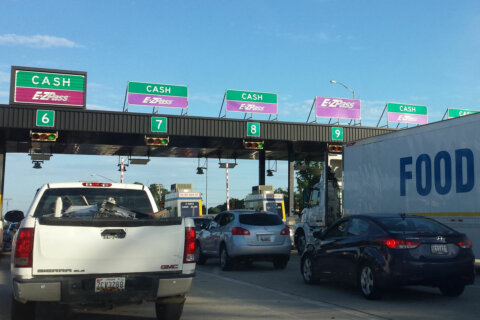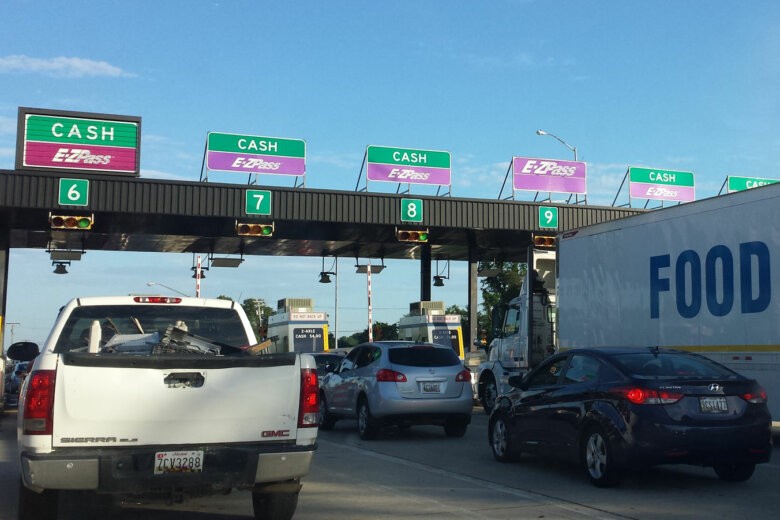This article was republished with permission from WTOP’s news partners at Maryland Matters. Sign up for Maryland Matters’ free email subscription today.

If a series of proposed changes goes into effect, Maryland motorists who drive certain vehicles will get a break at the toll booth, and those who refuse to get an E-ZPass transponder will gain new, faster ways of paying their tolls.
The changes are among several that the Maryland Transportation Authority board recommended in July. A public comment period runs until Oct. 3 and the first of nine public hearings is being held Tuesday evening.
The proposals are part of a gradual push by the state toward cashless tolling.
There are three basic changes the authority is recommending:
— Tweaks to the state’s vehicle classification would make it possible for “light” two-axle vehicles pulling a car or a trailer — like an RV towing a car or a landscaping truck pulling an equipment trailer — to pay less than they do now. Currently, such vehicles pay the same toll as heavier trucks.
RV’s or small trucks pulling a single-axle vehicle would get a 25% discount; those pulling a two-axle vehicle would see a 17% discount.
MDTA Executive Director James F. Ports Jr. said motorists, particularly small-business owners, have been asking for those reclassifications “for decades.”
“We couldn’t give it to them because we didn’t have the technology,” he said, “but under this contract we do.”
In addition, motorcycle tolls would drop 50%.
— The MDTA is proposing a “pay by plate” system for motorists who prefer not to get an E-ZPass transponder, even though they are now free.
Under pay by plate, motorists give their credit card information to the agency, and when they go through a tollbooth, their card is billed automatically.
“It’s a benefit for customers who don’t use our facilities very often as well as customers who are not interested in keeping a pre-paid balance on an E-ZPass account,” said Kelly Melhem, the authority’s director of Communications.
“You go through [the toll plaza] without a valid E-ZPass and the system will take an image of your license plate and… it will deduct the amount of the toll.”
For motorists who refuse to get a free E-ZPass transponder or give their credit card to the state, the authority is proposing “video tolling,” a system in which vehicle owners will receive an invoice by mail after incurring a toll.
Because state transportation officials want motorists to get E-ZPass transponders, they will continue to receive a discount on their tolls, typically $1. Drivers who use pay-by-plate will pay the same toll as cash customers. And video tolling customers will pay 150% of the base — or cash — rate.
“E-ZPass is certainly the best and the easiest way to use our facilities, absolutely,” Melhem said.
— The MDTA is proposing a 15% discount for video tolling customers who pay before the state mails an invoice, as an inducement to get them to pay their bill before the authority incurs the expense of processing and sending the notice.
A ‘dynamic’ system
Ports, a former GOP state delegate, said the proposals will save motorists $28.1 million over the next five years.
“We try to operate more like a business,” he said.
The authority has been able to shave costs in recent years, he added, and the toll reductions are an opportunity to “share some of those savings.”
In a recent Maryland Matters article, several state lawmakers and transportation advocates took issue with the toll rollbacks.
They claimed that the state is crying poverty — claiming it doesn’t have enough money to fund a long list of transportation needs — at the same time it’s proposing cuts to a key revenue stream.
In an interview, Ports rejected those arguments.
He said reduced tolls “could” produce greater revenue, not less, because motorists may make different decisions about which route to take.
“That’s how real economics works in the dynamic economy,” he said, drawing a retail analogy. “Why does a store have a sale? To make more money.”
Ports asserted that a previous toll cut and the decision to make E-ZPass transponders free triggered a revenue windfall for the authority.
“We’ve generated $94 million more just from dropping the tolls [and] dropping the fee,” he said, “because we were rewarded by people using the system more.”
He conceded that there are many factors — including the overall health of the economy and the price of fuel — that determine how much and where people choose to drive.
Ports also said critics of the state’s decisions fail to grasp the nuance of transportation funding — with MDTA, a self-sustaining entity, operating independently of the Maryland Department of Transportation.
MDOT, which collects fuel tax revenues, oversees the Transportation Trust Fund.
“The people [quoted in the article] weren’t totally informed about how these different pots of money work,” he said.
A gradual move to cashless tolling
The transportation authority’s proposal to institute “pay by plate” and “video tolling” is a part of a long-term move toward an all-electronic toll system and the elimination of toll plazas.
Toll plazas at the Francis Scott Key Bridge and Hatem Bridge are being removed in October.
The Key Bridge takes Baltimore Beltway (I-695) traffic across the Patapsco River. The Hatem Bridge carries U.S. 40 traffic across the Susquehanna River in Cecil County.
There are no formal proposals to go to all-electronic tolling now, but it’s clearly the future, both in Maryland and around the U.S.
“That is where we are looking long term and for the future,” Melhem said.
Cashless tolling, she said, “brings the benefits of less congestion, improving traffic flow and safety both for drivers and for our employees… [along with] less engine idling and less emissions.”
The Maryland Transportation Authority’s public hearings take place from Sept. 3-19. A schedule has been posted online.








